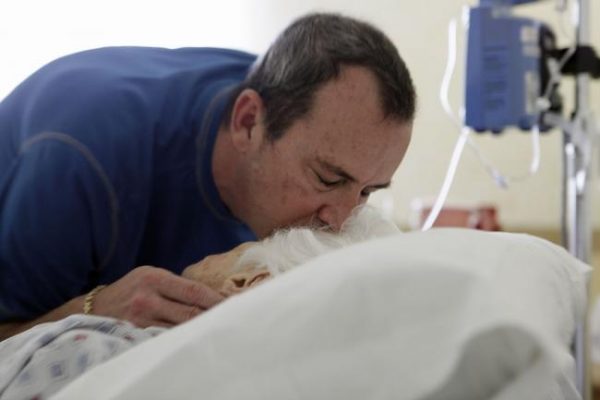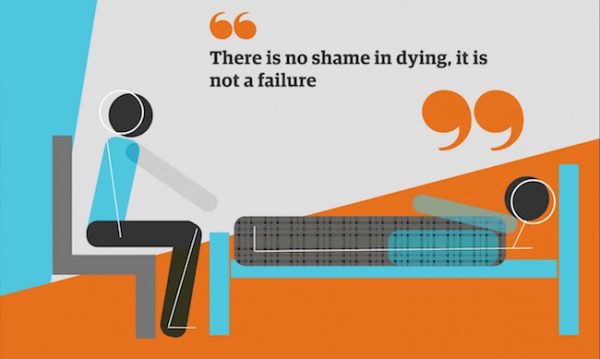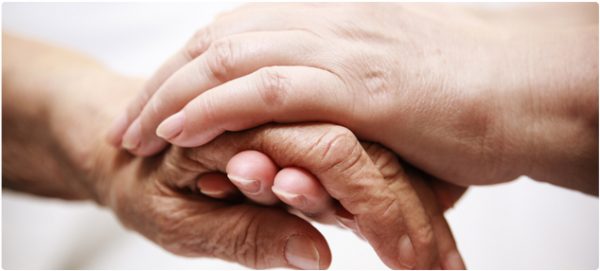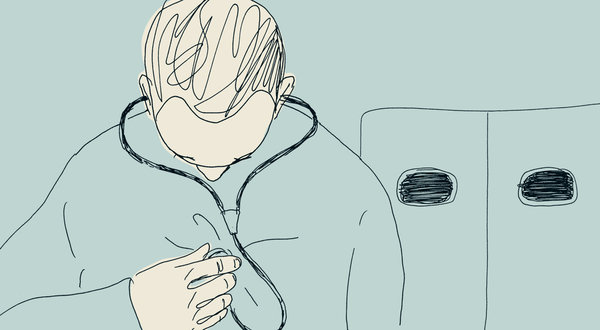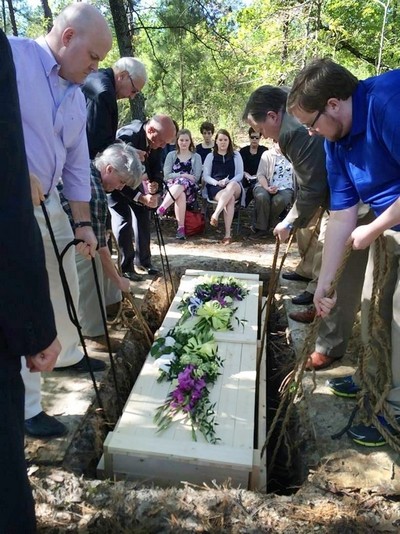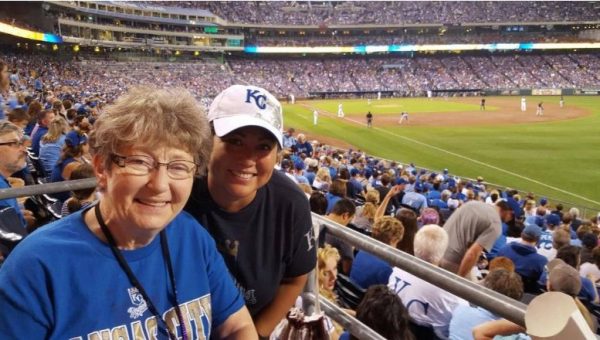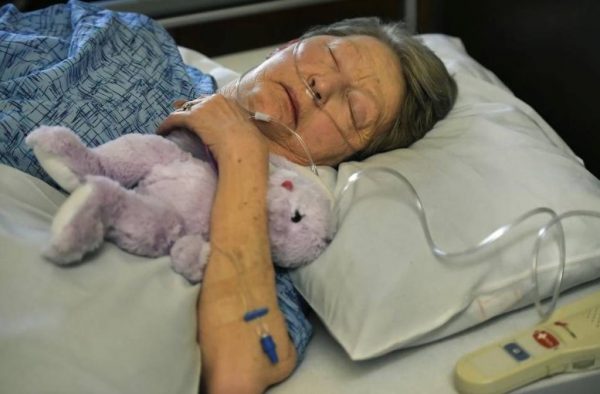When It Comes to Pregnancy Loss, There’s So Much We Don’t Talk About or Understand
by Angela Garbes

Two and a half years ago, six weeks into a wanted pregnancy, I woke up bleeding.
Thick globs of tissue, clots, and tangles of matter dropped out of me, staining my inner thighs and clothing, and sliding down the sides of the toilet. I called a consulting nurse, who calmly walked me through a few questions. Bleeding is normal, she assured me, as I sat silently on the other end of the line, upset, seething, and not believing a single word that came out of her mouth. I hated her. I hated my body for what felt like a betrayal.
It was November, and my husband and I had planned to tell our families about the pregnancy at Christmas.
The nurse told me to wait a few hours and, if I was still bleeding, to come in so they could draw my blood to check my hCG level. Human chorionic gonadotropin, or hCG, is a pregnancy hormone that doubles every two to three days during early pregnancy.
That afternoon, the bleeding had become heavier and thicker. I went in for the blood test. The next morning, my doctor called with the results, telling me that they were inconclusive and that I should probably come in for another test tomorrow to make sure that my level was dropping, and that I was in fact miscarrying. But I didn’t need another test to tell me what I already knew.
It was a full week before I stopped bleeding. I knew that what I was losing was matter, cells—not a baby. And yet the matter, for a couple of weeks, annihilated my rational mind. In just six weeks of pregnancy, nothing in my life had really changed. And yet, as it slipped and oozed out of me and I was powerless to stop it, it was replaced by a screaming sense of loss.
The only reason I didn’t stay facedown on my floor for a day, or a month, was because my husband insisted that I go to work. He never tells me what to do (he’s smarter than that), and that’s probably the only reason I listened. Recently, I asked him why he insisted I go to the restaurant that night and wait tables.
“Sometimes when people are really raw, the easiest way to get through the hardest part is to stay busy,” he said. “It wasn’t about not dealing with things—you knew what was happening—but reminding yourself that the world wasn’t over. I wanted you to be able to get away from it for a little bit.”
I worked that night, but as I walked the floor, smiling, serving steaks, busing tables, and opening bottles of wine, I could feel my own juices running out of my body. I couldn’t get away from it that day, not physically, and not ever.
After I started telling people what had happened, many of them told me not to worry. They pointed out that at least I now knew I could get pregnant. Over and over, I was told I could try again. For many women who have experienced pregnancy loss, healing becomes contingent on hope, on another pregnancy. But those directives, which come from well-meaning partners, family members, and health-care practitioners, can get in the way of the more complex, healthier—and often slow—process of grieving and recovery.
For a few weeks, that embryo the size of a pea suddenly felt like an unfathomably large black hole into which, at moments, my sanity was at risk of being sucked.
I drank. A lot. I didn’t sleep well. I cried, seemingly all the time. I watched videos of Beyoncé talking about her miscarriage—”The saddest thing I’ve ever been through”—on YouTube over and over.
Instead of telling our families I was pregnant that Christmas, my husband and I did something else. We flew to Little Rock, Arkansas, on Christmas Day, rented a car, and drove to Memphis, where we spent a few days eating barbecue and fried chicken, and drinking bourbon. We paid $10 each at the door of a juke joint where the price of admission included a red Solo cup, allowing us to help ourselves to unlimited refills from a keg that sat on the floor, late into the night. We were sad, but we were drunk, and we talked loudly about the importance and beauty of our freedom.
The next day, we went to the National Civil Rights Museum at the Lorraine Motel, where we each stood in the exact spot where Dr. Martin Luther King Jr. was assassinated. In Arkansas, we hiked on the Trail of Tears, walking part of the route that members of the Choctaw, Cherokee, Muscogee, Seminole, and Chickasaw nations took, fighting disease and starvation after the United States government forcibly removed them from their ancestral homelands.
We drove through Money, Mississippi, where, in 1955, 14-year-old Emmett Till was beaten, mutilated, and murdered, his body thrown into the Tallahatchie River, for talking to a white woman. In Jackson, the capital of Mississippi, I saw a family burning wood and trash in a drum on their front lawn. The windows of their house were broken; the fire was for heat. It was in that moment that I understood fully that while my loss was sad, it was not a tragedy.
As we drove north back to Little Rock, I stared out the window as the landscape whirred by and repeated the lines of Elizabeth Bishop’s poem “One Art” inside my head like an incantation: “So many things seem filled with the intent / to be lost that their loss is no disaster.”
Two months later, I still hadn’t gotten my period. I called my doctor. He ordered another hCG test to determine whether my body was back to a state of normalcy or whether my uterus was still holding on to any “retained products of conception,” the clinical term for placental and fetal tissue that can remain after a miscarriage. My hCG level was six, or “very slightly elevated,” meaning inconclusive. And so another test was ordered for the next week.
This new test would determine whether I might need a D&C, a surgical procedure of dilation and curettage, to “completely evacuate” my uterus. During a D&C, a woman’s cervix is dilated, and an instrument called a curette is used to scrape and remove the uterine lining.
The day after my blood was drawn, my cell phone rang a few minutes before 8 a.m. It was January, so the room was black. I shot up in bed and fumbled around for my phone. My husband, moving more quickly than he usually does at this hour of the morning, headed downstairs to make coffee and give me some privacy. We both knew who was calling.
I scrambled out of bed and tried to pull myself together, as though my doctor might actually be able to see me over the phone. I was naked and possibly still a little drunk from the night before (there had been martinis, then dinner, wine, and, improbably, shots of tequila and dancing). I had wanted to be more prepared for whatever he was about to tell me.
“Hello!” I said with forced energy. The fake sound of my own voice startled me. “Hello, hi, this is Angela,” I tried again.
“Good morning, Angela.”
As soon as I heard his voice—always so unnervingly calm—I stopped moving. What I wanted to hear was that my hCG level was back to zero, my uterus was empty, and I would not have to be scraped. But I understood that nothing, certainly not a thin layer of cotton, certainly not the cold, dark room I was in, could shelter me from the results of the blood test.
My doctor cleared his throat. “I think you’re pregnant,” he said.
“No, I don’t think so,” I replied confidently, dismissively.
He paused.
“Sorry, let me start over. Angela, this is your doctor calling. I’m calling to tell you that you are pregnant. Last week, your hCG level was six. Today it is 1033. The only way that happens is pregnancy.”
I have been pregnant—knowingly—four times in my life. Before I gave birth to my daughter at the end of 2014, I’d had a miscarriage in 2008, an abortion in 2009, and another miscarriage in 2013. Half of my pregnancies have ended in miscarriage. This might seem shocking, but it’s actually quite ordinary.
According to a 2013 study by researchers at the Albert Einstein College of Medicine, most people believe that miscarriage is a rare occurrence that happens to only 5 percent of women. In reality, miscarriage ends up to 20 percent of known pregnancies—roughly 750,000 to 1,000,000 every year in the United States. The true percentage is almost certainly higher considering the number of women who miscarry so early that they may never recognize the pregnancy as anything more than a late period.
Let’s talk for a moment about the term “miscarriage.” It’s objectively terrible. Think of the words that begin with the same prefix: mistake, misstep, misplaced, misspelled. “Mis” seems to imply not only that something is wrong, but that you have an active role in making it so. Forty percent of the women surveyed who have experienced a miscarriage said they felt they had done something wrong to cause their miscarriage, and 47 percent expressed feeling guilty.
Scientists know that the majority of pregnancy losses are caused by aneuploidy—chromosomal abnormalities that, for reasons we don’t totally understand, result in forms of life that are incapable of being carried to term. Fetuses with other chromosomal irregularities, such as Down syndrome and Klinefelter’s syndrome, can still grow into healthy, full-term babies.
Yet the same 2013 survey found that the most commonly believed causes of miscarriages are things like stressful life events, lifting something heavy, and having previously used a contraceptive intrauterine device (IUD). These all suggest some responsibility on the part of women.
And they all are unrelated to miscarriage.
There’s a lot that scientists don’t know about pregnancy loss—not to mention about women’s bodies and our reproductive health in general. It was only in the 20th century that researchers came to understand menstruation as part of our species-sustaining reproductive process, and not a scourge that caused food to spoil and puppies to fall over dead.
Before this revelation, people relied on information from sources like the Bible, which, in Leviticus 15:19-20, says: “Whenever a woman has her menstrual period, she will be ceremonially unclean for seven days. Anyone who touches her during that time will be unclean until evening. Anything on which the woman lies or sits during the time of her period will be unclean.”
Roman historian Pliny the Elder wrote: “Contact with [menstrual blood] turns new wine sour, crops touched by it become barren, grafts die, seeds in gardens are dried up, the fruit of trees falls off, the bright surface of mirrors in which it is merely reflected is dimmed, the edge of steel and the gleam of ivory are dulled, hives of bees die, even bronze and iron are at once seized by rust, and a horrible smell fills the air.”
That may sound antiquated and superstitious, but as recently as 1974, a leading medical journal, the Lancet, published a letter speculating that flowers held by menstruating women would wilt as the result of “menotoxin,” an invisible, nefarious substance secreted through the pores of women who happen to be on their period. The actual existence of menotoxin was debated for the better part of a century. To be clear: It’s a myth. There is no such thing menotoxin, or “menstruation poison,” and there never was.
Though women’s reproductive health is crucial to the survival of our species, we haven’t valued it enough to fully study and understand it. We still haven’t even managed to figure out what triggers labor—the physical process by which every single human is brought into the world.
Most of what we understand about miscarriage didn’t come from direct research. Instead, discoveries came about accidentally, the byproduct of work done by scientists whose fields of inquiry were things like chromosomal abnormalities or mammalian placentas. These researchers analyzed spontaneously aborted fetuses and products of conception simply because they were in convenient, abundant supply. Why no one thought to study the reasons why they were in such supply is mind-boggling.
The clinical term for miscarriage is “spontaneous abortion,” which feels, yes, clinical. For everyday life, I prefer the term “pregnancy loss,” because that’s exactly what it is. What exactly is lost, though, lies entirely in the heart and mind of each woman who experiences it.
People are uncomfortable talking about pregnancy loss, so they don’t. It’s no wonder—any meaningful discussion of it requires acknowledging death, sadness, blood, tears, and items being expelled from the vagina.
It doesn’t help that what paltry conversations we do have about pregnancy loss are dominated by stories of people who have been through multiple, consecutive losses. And books on the subject, even ones grounded in science, are typically written by men and strongly emphasize hope—the importance of getting over a pregnancy loss in order to try again. With titles like Miscarriage, Medicine & Miracles, these books are about fixing problems, reinforcing that you can and will get pregnant again as the goal.
“Recurrent pregnancy loss” is defined as three or more consecutive losses. While would-be parents who struggle through this and are still determined to have children must have access to information and hope, the reality is that recurrent loss affects only 1 to 2 percent of women.
“[Recurrent pregnancy loss] is a tragedy,” said Dr. Kristen Swanson, dean and professor at the College of Nursing at Seattle University. “But that’s not the everyday version of miscarriage.”
Swanson should know. She began studying pregnancy loss 28 years ago as a doctoral student. Since then, she has interviewed and counseled hundreds of women about pregnancy loss and care. Swanson was also dean of the School of Nursing at the University of North Carolina, and, for more than 20 years, on the faculty of the University of Washington School of Nursing.
As a PhD student in the 1980s, Swanson, who had just given birth to her son, attended a support group for new mothers. On that particular day, the group hosted a guest speaker, an obstetrician who spoke about pregnancy loss.
“I listened like a nurse,” she recalled, “because he was using words like ‘spontaneous abortion,’ ‘products of conception,’ ‘diagnosis,’ and ‘prognosis’—medical terms.”
Afterward, women in the group were eager to share their own experiences. Swanson was struck by the markedly different words the patients used: They spoke of loss, grief, babies, emotions, and mourning.
“There are two totally different languages used by practitioners and women who have experienced pregnancy loss,” Swanson said. “My awareness happened in that moment. I knew this was something I could study.”
Swanson thought she would send out a survey to a few hundred women and then write a paper. She found that not only was nothing written on the subject at that time, there was not even any meaningful tool of measurement. So she created her own. She asked women two questions about their losses: What is it like? What made you feel cared for?
“We should always take miscarriage as an absolutely normal life event,” said Swanson. “It’s a transition, part of living and dying. Every single day, your body is sloughing off fluids and cells that may be harmful to you. With miscarriage, you are entering a very natural process. The body is wise. It recognizes a pregnancy that could never be carried to term.”
In the very early stages of pregnancy, the production of hormones—the chemical directives parts of our bodies send to other parts to compel them into action—increases. Women’s bodies are suddenly awash in a strange soup of estrogen and progesterone, which affect everything from the breasts to the bowels to the brain. (By frustratingly sudden turns, these hormones can make you feel exhausted, incredibly aroused, or nauseated.) When pregnancy loss occurs, suddenly all those hormones rush away, and women may easily be swept up in a chemical ebb tide.
“The emotions that go with [miscarriage] can be huge,” said Swanson.
Then comes the reckoning of what was lost, which is unique to each person. The reactions to pregnancy loss are as diverse as the women who experience them—essentially infinite.
Based on her interviews with women, Swanson developed a Theory of Caring that’s based not in sympathy, which is what most people tend to throw at women who have experienced pregnancy loss, but empathy.
In Swanson’s definition of care, nurses treat and nurture their patients with a personal sense of responsibility. Her theory defines specific acts health-care providers can perform: knowing, being with, doing for, enabling, and maintaining belief. According to Swanson, the belief that must be maintained is the belief that a woman can recover and work through pregnancy loss—not that she will, or even want to, get pregnant again.
Swanson’s Theory of Caring, though it was created specifically to care for women who had experienced pregnancy loss, has since been adopted as a model for general nursing and patient-driven care at hospitals around the country.
I wonder what else we might learn simply by listening to women.
The experience of pregnancy loss can be wildly divergent, even within one life.
My first miscarriage happened eight years ago, just days after a doctor’s appointment. My doctor at the time had asked me a routine question—the date of my last period. I couldn’t quite remember, and then I realized it had been more than six weeks earlier.
She ordered a urine test; I was pregnant. I wandered out of the clinic onto Madison Street and called a friend, who within minutes picked me up by the IHOP near Broadway. A few hours later, my boyfriend, the man who would later become my husband, picked me up at her apartment, where I had been sitting on the couch crying.
I—we—did not want to be pregnant.
Two days later was when I started bleeding. I went back to the doctor’s office, where they performed an ultrasound with a long wand that was inserted into me. “There is nothing in there now,” I remember someone saying. “You must have miscarried.”
I didn’t ask any questions. I don’t remember feeling anything besides relief. My body had made an executive decision, and I felt grateful to it for that.
But five years later, when I was pregnant again and my husband and I were excitedly planning to tell our families at Christmas, the circumstances had changed. I still remember, on that morning that I began bleeding heavily, hanging up with the doctor and starting to walk the three feet from my bedroom to my bathroom and not getting all the way there. Instead, I lay down on the carpet in the hallway and sobbed for an hour.
A friend of mine, someone I used to work with, recalled a similar experience. She and her wife have been trying to get pregnant for the last two years, and she’ll be the one to carry the baby. She’s been inseminated four times and gotten pregnant twice. Both ended in miscarriage. Her first pregnancy came, much to her surprise, on the first attempt.
“It was literally the first time I’ve ever had sperm in my body,” she remembered. “Suddenly, it felt real, like a whole new life—this could be it, our baby, our family.”
But the pregnancy stopped at eight weeks.
“The first miscarriage was devastating,” she said. “Even being with a woman, my wife still doesn’t understand how crazy those hormones make you. I felt like I was losing my mind a little.”
As I sat listening to her, I marveled at the fact that, two years ago, we were miscarrying at the exact same time. Working side by side, bleeding side by side, each secretly worried that, at any moment, we’d come undone. It was only months later that we found out all of this because we chose, in spite of all our hesitations, to talk about it.
My husband recently reminded me of something I’d forgotten. He said that the next day, the day after I lay on the carpet crying for an hour, when I was bleeding the heaviest, I had called him into the bathroom. I was sitting on the toilet passing large blood clots. I wiped them away and held out the piece of toilet paper to show him. I hadn’t remembered doing that. I apologized because apologizing seemed like the polite thing to do, but I didn’t mean it. I was glad that I had done it. That he had seen it too.
It.
It was gelatinous, the texture of snot, and the deepest shade of red I’ve ever seen—nearly black. As it fell out of me, I looked closely, both hoping and fearing that I would see something recognizable—a tadpole, a cashew-shaped alien, a tiny eye the size of a poppy seed on something that vaguely resembled a head. I was fascinated by the stuff. It may not have been a baby, but it was part of me—something I grew with my own body. And now it was leaving me. I rolled it in my fingers. It was warm. It was not alive.
I was surprised to learn from Swanson that I was not alone in my need to touch what came out of me. In fact, touching—and being able to talk about it—is a powerful experience for many women. If a woman Swanson was interviewing had had access to the products of conception, she asked questions about it: Did you pass anything? Did you scoop it up and feel it?
“‘I DID,’ they’d say with huge eyes,” Swanson said. “So then I’d ask them, ‘What did you feel?’ ‘What was the shape of it?’ These are the most intimate moments I have ever experienced while counseling women. They want to tell that story, but they don’t get many places to tell it.”
For me, the most difficult part of that second pregnancy loss was attempting to make sense of so many new and entirely unrecognizable feelings. I found myself grieving someone I had never known, someone who, to be honest, I never even thought of as a person. How (not to mention why) do you mourn someone who never came into being?
“Women will ask themselves, ‘What did I lose?'” Swanson told me. “Some will say ‘not a darn thing,’ others will say ‘my child.’ Everybody has to come to terms with what was lost and gained.”
I remember my mother driving my husband and me to the airport on Christmas morning, when we left for Little Rock. We had told her about the miscarriage the day before. Just as she was about to get back in the car, she waved and said cheerfully: “Have fun! Made in Memphis! Made in Memphis!”
I felt her love, but it didn’t bring me much comfort. That came a few weeks later while talking to my friend Erica on the phone. After going through a miscarriage several months earlier, she was pregnant again.
“If I have another miscarriage, I’m done,” she told me matter-of-factly.
Until then, no conversation I’d had or reading I’d done had left any room for the possibility of not trying over and over to get pregnant again. There seemed to be no space for the possibility of finding peace in a life without a baby. I realized then that if I lost more pregnancies, I wouldn’t be going to any great lengths to have a child.
My ex-coworker, the one who has had two miscarriages, told me that she has also made peace—both with the fact that she might not be able to carry a baby, and that she and her wife are determined to meet their child. They’ll keep trying, or they’ll adopt, or they’ll wait until her wife is ready to get pregnant. Miscarriage might stop her from having a baby, but it won’t stop her from having a family.
When it comes to pregnancy loss, there is no script to follow. To help a woman navigate it, you don’t need to offer advice or perspective. It is enough to show up, however awkwardly, and be there. To listen.
“What does it take to lean into it, to allow your body to go through the emotions that come from doing what we’re hardwired to do?” Swanson wondered aloud at one point. “Women were made for birth and life and death,” she added. “In the moment of miscarriage, birth and life and death come through us.”
On that cold morning in January 2014, after my second pregnancy loss, I stood there, still in the dark, still possibly drunk, still on the phone with my doctor. Only now I was pregnant.
My first question was if there was any greater chance that I would miscarry. I had already googled this weeks before, and knew that the risk was about 25 percent, barely higher than someone who has never lost a pregnancy. (My second question, which I kept to myself, was whether I had unknowingly killed or pickled my proto-baby while drinking the night before. She was fine.)
“This probably isn’t what you want to hear,” he said. “But I wouldn’t consider you abnormal until this”—pregnancy loss—”happened to you three times in a row.”
“So what do I do now?” I asked.
“Live your life. Come see me in a month.”
I waited until I was 14 weeks pregnant with the little being that would become my daughter Noli Jo before I started telling people. And even then, I still held on to a lot of fear. I don’t remember when exactly I let go of the fear, but I do know that, when I told others, it was their happiness that made the pregnancy seem viable and real. They seemed to have nothing but hope and belief.
We are often told to accept life’s difficult circumstances, in part because we can learn from them. Gradually, we think of them less as things that happened, but things that are a part of us. The same can be true for pregnancy loss.
Weeks after talking to Kristen Swanson, I couldn’t stop thinking about something she said—that birth and life and death exist in women’s bodies simultaneously.
I picture pregnancy loss as a primordial river rushing through me; it carries forces so big, they eclipse my imagination. It runs through my femoral artery and vena cava, through my spleen, my brain, and the chambers of my heart. At first, this force is strong like rapids, flooding everything. With time it slows, but it never goes away. It rearranges my cells like stones in a riverbed. It never stops running, even after I can no longer see or feel it.
Someone once suggested that if I hadn’t lost a pregnancy, I wouldn’t have the beautiful baby I have now. She was trying to make me feel better, I think, or to help me make sense of things. It was a mistake. I remember looking at her face and thinking that if I hadn’t had my miscarriage, I wouldn’t be the person I am now.
Complete Article HERE!

